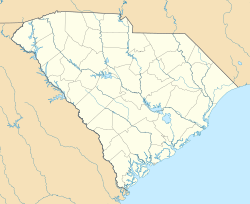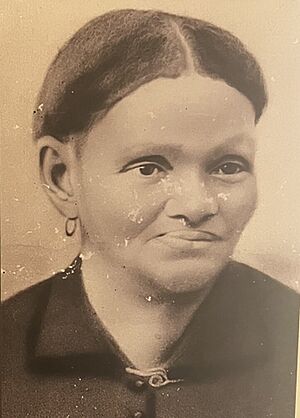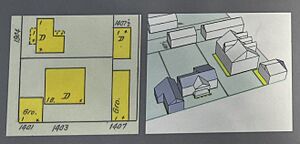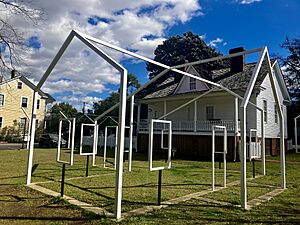Mann-Simons Cottage facts for kids
Quick facts for kids |
|
|
Mann-Simons Cottage
|
|
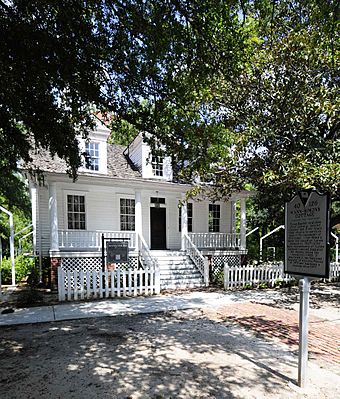
Mann-Simons Cottage, September 2012
|
|
| Location | 1403 Richland St., Columbia, South Carolina |
|---|---|
| Area | 0.3 acres (0.12 ha) |
| Built | 1875 |
| Architectural style | Columbia Cottage |
| NRHP reference No. | 73001726 |
| Added to NRHP | April 23, 1973 |
The Mann-Simons Cottage is a historic house in Columbia, South Carolina. It stands at the corner of Richland and Marion streets. This special house tells the story of a Black family who were free before and after the American Civil War.
In 1843, Ben DeLane, a man who had gained his freedom, bought the land for his wife, Celia Mann. Their daughter, Agnes Jackson Simons, inherited the house when Celia passed away in 1867. The original house was replaced in the 1870s with the "cottage style" house you see today. The Mann-Simons family owned this property until 1970.
The house became a museum in 1978. It is important because it shows what life was like for free Black people in Columbia during the time before the Civil War and during the Reconstruction era that followed.
The cottage built around 1872 to 1880 has a raised front porch. Four columns support its roof. It also has three windows that stick out from the roof, called dormers. Other buildings, like a grocery store, used to be on the property but are no longer there.
Contents
A Family's Story: The Mann-Simons Cottage
Celia Mann: A Community Leader
Celia Mann was born into slavery in Charleston, South Carolina, in 1799. Her husband, Ben DeLane, likely bought his freedom by working as a boatman. In 1843, Ben bought a large piece of land in Columbia for Celia. It is not known exactly when Celia became free, but she was listed as a free person in the 1850 United States census.
Celia Mann was a midwife, helping mothers deliver babies. She was a respected leader in Columbia's free Black community. In 1850, free Black families made up about 6 percent of Columbia's population. After the Civil War, the Cavalry Baptist Church, a Black Baptist church, started meeting in Celia's house. Celia passed away in 1867. In her will, she left the property to her daughter, Agnes.
Agnes Jackson Simons: Developing the Property
Agnes Jackson was born in South Carolina in 1831. She was Celia's daughter. In 1853, her first child, Hattie Jackson, was born. Before 1858, Agnes married William "Bill" Simons, a free Black man and a popular musician.
After Celia's death in 1867, Agnes and William made many improvements to the property. They replaced the first house with the larger "cottage style" home we see today. They also built other structures, including one that was a lunch counter and later a grocery store.
Charles Simons: A Prominent Figure
When Agnes passed away in 1907, her son Charles inherited the property. Charles was an important person in the Black community. He was a deacon in the Baptist Church and a Freemason.
In 1912, Charles bought more land next to his property. He built three two-story houses there and rented them out. Even though the area was historically a Black neighborhood, Charles rented these new houses mostly to white people after 1913. These new tenants were often immigrants from Eastern and Southern Europe. Owning these rental properties helped Charles achieve a comfortable life. This was something many Black South Carolinians could not do in the early 1900s.
Later Generations: Keeping the Legacy Alive
After Charles died in 1933, his wife, Amanda Green Simons, inherited the property. Amanda was a dressmaker and a respected figure in the Black community. She sold the rental houses, bringing the family's land back to its original size.
When Amanda passed away in 1960, the property went to her niece and adopted daughter, Bernice Conners. Bernice was the last family member to live in the 1870s house. In 1970, the Columbia Housing Authority bought the property.
Saving the Mann-Simons Cottage
In 1970, the Columbia Housing Authority planned to tear down the historic house. They wanted to build apartments for seniors. However, a group of people, led by Robbie Atkinson, who was Celia Mann's great-great-granddaughter, started a campaign to save the house. The Black community strongly supported this effort.
Their hard work paid off! In 1973, the house was listed on the National Register of Historic Places. The Richland County Historic Preservation Society bought the house and managed it as a museum.
In 1994, the city of Columbia bought the site. The Historic Columbia Foundation now takes care of it. Between 2006 and 2012, archaeologists did a lot of work at the site. This helped them learn more about the property's history.
Today, Black community groups, like the Wisteria Garden Club and the Calvary Baptist Church, are still very involved. They help share the story of the Mann-Simons Cottage. Their ideas helped shape how the site is presented to visitors today.
External links
- Manns-Simons Site - Historic Columbia Foundation


